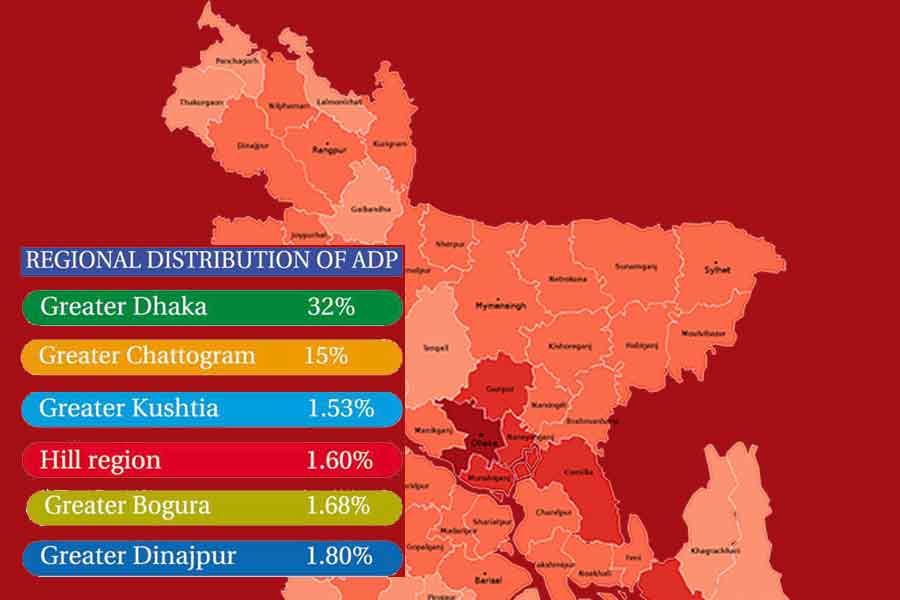‘Top seven districts get 50pc of ADP allocation, bottom 25 get only 13pc’
Institute for Planning and Development (IPD) research shows

Published :
Updated :

The country's top seven districts, including Dhaka and Chattagram, are getting 50 per cent allocation of the annual development programmes (ADP) while the bottom 25 districts are getting only 13 per cent, indicating major discrepancy in the ADP distributions, a study found.
The study findings revealed on Saturday said according to the disparity measure, Palma ratio, which has a value of 3.72, indicates high disparity in development budget allocation within the country.
It further said poverty situation in many regions, especially northern region, has been constant for 50 years of the country's independence though poverty has been reduced nationally.
Institute for Planning and Development (IPD) conducted the research titled Regional Pattern of Annual Development Budget Allocation in Bangladesh.
The study was run on behalf of IPD by planner Redwanur Rahman and executive director of the organisation Prof Adil Muhammad Khan.
Dhaka district is getting 21 per cent of the development allocation, but Cox's Bazar is in second place (9 per cent) due to the ongoing projects including power projects, said Prof Adil Muhammad Khan.
IPD conducted a spatial analysis of the 2021-22 annual development budget of 12 sectors leaving the general public service, defense and public order and security sectors taking into consideration 70 per cent of the ADP projects.
However, the study did not include the country's nationally important mega projects such as Ruppur Nuclear Power Plant, Padma Multipurpose Bridge, Padma Rail Bridge and Bangabandhu Rail Bridge on Yamuna River considering the national impact.
The research said regional disparities in Bangladesh's development budget allocation are still visible.
It found that the poverty rates are very high in the country's north-western region (Panchgarh, Thakurgaon, Lalmonirhat), north-eastern region (Netrakona, Sunamganj, Kishoreganj, Habiganj) and central-south region (Meherpur, Chuadanga, Magura, Rajbari) where ADP allocation is significantly less than the central regions--- Dhaka and southeastern and Chittagong region.
Adil Khan said various development projects including mega projects in the infrastructure, communication and power sectors are underway in the backward areas such as Patuakhali, Khulna, Cox's Bazar etc., which will accelerate the regional development of these areas.
He said as the spatial and regional considerations of development budget allocation are not considered in the mainstream of development plans, the overall development of the country is still unbalanced.
He also said to ensure balanced development of the entire country by making a transition from this situation, the development plan and budget allocation should be ensured taking into consideration the regional reality.
Regionally, greater Dhaka region (old big district) is getting 32 per cent allocation and Chittagong region 15 per cent.
On the contrary, greater Kushtia is getting 1.53 per cent share, hill region 1.60 per cent, greater Bogura 1.68 per cent and greater Dinajpur 1.80 per cent share, which are the lowest allocations.
In the event, IPD Adviser Professor Aktar Mahmud said to ensure balanced regional development of Bangladesh, a special economic development plan needs to be adopted for the development of specialised areas such as hilly areas, southern areas, haor areas and char areas.
After analysing why the poverty rate of Char Rajibpur area of Kudigram is 79 per cent even after 50 years of independence, it is necessary to allocate special budget and take sustainable economic initiatives for such areas.
Development researcher Redwanur Rahman said economic zones are being developed in Bangladesh through public-private initiatives, which is commendable.
But even in this case, most of the economic zones are in Dhaka and Chittagong regions, which is in conflict with the government's decentralisation policy of development, he said.
Associate Professor of Urban and Regional Planning Department of Jahangirnagar University Farhadur Reza said it is necessary to undertake projects and development initiatives through spatial mapping of development plans and development budget allocation.
Ashrafuddin Fahim, teacher of Pabna University of Science and Technology, said although small and cottage industries have developed in Pabna and its surrounding areas, private large-scale investment is absent here.
Cooperative Zonal Institute representative Salimul Alam said new projects should be taken for northern region.
bdsmile@gmail.com


 For all latest news, follow The Financial Express Google News channel.
For all latest news, follow The Financial Express Google News channel.